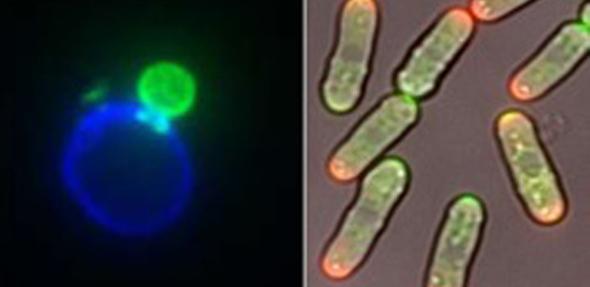
Cell polarity, spindle orientation and cell cycle progression in yeast
Cell cycle progression is controlled by fundamental mechanisms conserved between yeast and humans. Stage-specific events are driven by oscillatory activation of cyclin-dependent kinases (CDKs) and other core cell cycle regulators, while surveillance mechanisms known as Checkpoints monitor crucial steps to enforce orderly progression only after individual steps are successfully completed. Since the first checkpoint characterized in S. cerevisiae, the DNA damage checkpoint, this model system has contributed toward uncovering a variety of surveillance mechanisms faithfully conserved in humans. These mechanisms are critical to avert genetic instability and cancer.
S. cerevisiae divides asymmetrically into a larger mother and smaller daughter (the bud). In order to undertake this highly polarized cell division, an axis of cell polarity is established early in the cell cycle with the emergence of a new bud. As a result, two distinctive compartments are generated with a narrow constriction between them - the mother-bud neck. Thus, during mitosis the spindle must orient along this mother-bud axis to ensure the faithful partitioning of the replicated chromosomes across the bud neck.
Spindle orientation is under strict surveillance by the Spindle Position Checkpoint (SPOC) to ensure the coordination between chromosome partition and cell cycle progression out of mitosis. This checkpoint is based on molecular sensors located at the spindle poles that can read their position in the mother versus daughter compartment to generate signals that coordinate this spatial information with cell cycle progression. The SPOC is intrinsically linked to the establishment of cell polarity and regulates the progression of mitosis by controlling the Mitotic Exit Network, a signal transduction cascade that regulates the phosphatase Cdc14. I am using S. cerevisiae to study polarity establishment, its underlying mechanistic links to the SPOC and the integral control of cell cycle progression. Furthermore, I am also exploring related mechanisms for cell polarity control in the fission yeast S. pombe. To achieve an integral view, we exploit a variety of techniques ranging from live imaging to biochemistry and from high throughput genetics to molecular biology.
Control of spindle orientation is crucial for any system producing cells with different fates, as is the case in self-renewing stem cell divisions. Moreover, asymmetries built into the centrosome cycle of self-renewing stem cells have been effectively anticipated by studies in S. cerevisiae. Therefore, understanding the molecular basis of the SPOC in yeast will provide valuable insight into similar mechanisms in those and other asymmetric cell divisions. Finally, comparative studies in S. cerevisiae and S. pombe have been instrumental to achieve a universal view of cell cycle control mechanisms. Thus, exploring how these two models deploy conserved machineries to promote distinctive themes in cell polarity will contribute key lessons to understand general controls for cell shape and organization.
